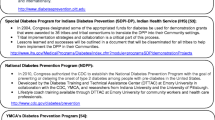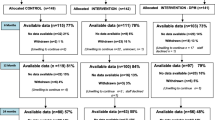Abstract
The aims are to define the regression rate in newly diagnosed type 2 diabetes after lifestyle intervention and pharmacological therapy based on a SMBG (self-monitoring of blood glucose) strategy in routine practice as compared to standard HbA1c-based treatment and to assess whether a supervised exercise program has additional effects. St Carlos study is a 3-year, prospective, randomized, clinic-based, interventional study with three parallel groups. Hundred and ninety-five patients were randomized to the SMBG intervention group [I group; n = 130; Ia: SMBG (n = 65) and Ib: SMBG + supervised exercise (n = 65)] and to the HbA1c control group (C group) (n = 65). The primary outcome was to estimate the regression rate of type 2 diabetes (HbA1c <6 % on metformin treatment). After 3 years of follow-up, diabetes regression was achieved by 56 patients, 6 (9.2 %) from the C group, 21 (32.3 %) from the Ia group and 29 (44.6 %) from the Ib group. RR (95 % CI) for diabetes regression in the intervention group (Ia + Ib) was 4.5 (2.1–9); p < 0.001 and remained after stratification by gender, age and BMI. This difference was associated with healthier changes in lifestyle and greater weight loss. RR for a weight loss >4 kg was 3.6 (1.8–7); p < 0.001. This study shows that the use of SMBG in an educational program effectively increases the regression rate in newly diagnosed type 2 diabetic patients after 3 years of follow-up. These data suggest that SMBG-based programs should be extended to primary care settings where diabetic patients are usually attended.


Similar content being viewed by others
References
Knowler WC, Barrett-Connor E, Fowler SE, Hamman RF, Lachin JM, Walker EA, Nathan DM (2002) Reduction in the incidence of type 2 diabetes with lifestyle intervention or metformin. N Engl J Med 346:393–403
Gerstein HC, Yusuf S, Bosch J, Pogue J, Sheridan P, Dinccag N, Hanefeld M, Hoogwerf B, Laakso M, Mohan V, Shaw J, Zinman B, Holman RR (2006) Effect of rosiglitazone on the frequency of diabetes in patients with impaired glucose tolerance or impaired fasting glucose: a randomised controlled trial. Lancet 368:1096–1105
Chiasson JL, Josse RG, Gomis R, Hanefeld M, Karasik A, Laakso M (2002) Acarbose for prevention of type 2 diabetes mellitus: the STOP-NIDDM randomised trial. Lancet 359:2072–2077
Tuomilehto J, Lindstrom J, Eriksson JG, Valle TT, Hamalainen H, Ilanne-Parikka P, Keinanen-Kiukaanniemi S, Laakso M, Louheranta A, Rastas M, Salminen V, Uusitupa M (2001) Prevention of type 2 diabetes mellitus by changes in lifestyle among subjects with impaired glucose tolerance. N Engl J Med 344:1343–1350
DeFronzo RA, Tripathy D, Schwenke DC, Banerji M, Bray GA, Buchanan TA, Clement SC, Henry RR, Hodis HN, Kitabchi AE, Mack WJ, Mudaliar S, Ratner RE, Williams K, Stentz FB, Musi N, Reaven PD (2011) Pioglitazone for diabetes prevention in impaired glucose tolerance. N Engl J Med 364:1104–1115
Bosch J, Yusuf S, Gerstein HC, Pogue J, Sheridan P, Dagenais G, Diaz R, Avezum A, Lanas F, Probstfield J, Fodor G, Holman RR (2006) Effect of ramipril on the incidence of diabetes. N Engl J Med 355:1551–1562
Zinman B, Harris SB, Neuman J, Gerstein HC, Retnakaran RR, Raboud J, Qi Y, Hanley AJ (2010) Low-dose combination therapy with rosiglitazone and metformin to prevent type 2 diabetes mellitus (CANOE trial): a double-blind randomised controlled study. Lancet 376:103–111
Perreault L, Kahn SE, Christophi CA, Knowler WC, Hamman RF (2009) Regression from pre-diabetes to normal glucose regulation in the diabetes prevention program. Diabetes Care 32:1583–1588
Weng J, Li Y, Xu W, Shi L, Zhang Q, Zhu D, Hu Y, Zhou Z, Yan X, Tian H, Ran X, Luo Z, Xian J, Yan L, Li F, Zeng L, Chen Y, Yang L, Yan S, Liu J, Li M, Fu Z, Cheng H (2008) Effect of intensive insulin therapy on β-cell function and glycaemic control in patients with newly diagnosed type 2 diabetes: a multicentre randomised parallel-group trial. Lancet 371:1753–1760
Chen HS, Wu TE, Jap TS, Hsiao LC, Lee SH, Lin HD (2008) Beneficial effects of insulin on glycemic control and beta-cell function in newly diagnosed type 2 diabetes with severe hyperglycemia after short-term intensive insulin therapy. Diabetes Care 31:1927–1932
Mingrone G, Panunzi S, De Gaetano A, Guidone C, Iaconelli A, Leccesi L, Nanni G, Pomp A, Castagneto M, Ghirlanda G, Rubino F (2012) Bariatric surgery versus conventional medical therapy for type 2 diabetes. N Engl J Med 366:1577–1585
Durán A, Martín P, Runkle I, Pérez N, Abad R, Fernandez M, del Valle L, Sanz MF, Calle-Pascual AL (2010) Benefits of self-monitoring blood glucose in the management of new-onset Type 2 diabetes mellitus: the St Carlos Study, a prospective randomized clinic-based interventional study with parallel groups. J Diabetes 2:203–211
Polonsky WH, Fisher L, Schikman CH, Hinnen DA, Parkin CG, Jelsovsky Z, Petersen B, Schweitzer M, Wagner RS (2011) Structured self-monitoring of blood glucose significantly reduces A1C levels in poorly controlled, noninsulin-treated type 2 diabetes: results from the structured testing program study. Diabetes Care 34:262–267
Thomas DE, Elliott EJ, Naughton GA (2006) Exercise for type 2 diabetes mellitus. Cochrane Database Syst Rev 19:CD002968
Snowling NJ, Hopkins WG (2006) Effects of different modes of exercise training on glucose control and risk factors for complications in type 2 diabetic patients: a meta-analysis. Diabetes Care 29:2518–2527
Andrews RC, Cooper AR, Montgomery AA, Norcross AJ, Peters TJ, Sharp DJ, Jackson N, Fitzsimons K, Bright J, Coulman K, England CY, Gorton J, McLenaghan A, Paxton E, Polet A, Thompson C, Dayan CM (2011) Diet or diet plus physical activity versus usual care in patients with newly diagnosed type 2 diabetes: the Early ACTID randomised controlled trial. Lancet 378:129–139
Balducci S, Zanuso S, Nicolucci A, De Feo P, Cavallo S, Cardelli P, Fallucca S, Alessi E, Fallucca F, Pugliese G (2010) Effect of an intensive exercise intervention strategy on modifiable cardiovascular risk factors in subjects with type 2 diabetes mellitus: a randomized controlled trial: the Italian diabetes and exercise study (IDES)FREE. Arch Intern Med 170:1794–1803
Totsikas C, Röhm J, Kantartzis K, Thamer C, Rittig K, Machann J, Schick F, Hansel J, Niess A, Fritsche A, Häring HU, Stefan N (2011) Cardiorespiratory fitness determines the reduction in blood pressure and insulin resistance during lifestyle intervention. J Hypertens 29:1220–1227
Martín Rojas-Marcos P, del Valle L, Fuentes Ferrer M, Runkle I, Duran A, Perez-Ferre N, Bordiu E, Cabrerizo L, Calle-Pascual A (2010) The lifestyle patterns in a Mediterranean population and its association with diabetes mellitus. MOPOR Case Control Study. Obes Metab 6:69–75
Holman RR, Paul SK, Bethel MA, Matthews DR, Neil AW (2008) 10-Year follow-up of intensive glucose control in type 2 diabetes. N Engl J Med 359:1577–1589
Ceriello A, Ihnat MA, Thorpe JE (2009) The “Metabolic Memory”: is more than just tight glucose control necessary to prevent diabetic complications? J Clin Endocrinol Metab 94:410–415
Scavini M, Bosi E, Ceriello A, Giorgino F, Porta M, Tiengo A, Vespasiani G, Bottalico D, Marino R, Parkin C, Bonizzoni E, Cucinotta D (2011) Prospective, randomized trial on intensive SMBG management added value in non-insulin-treated T2DM patients (PRISMA): a study to determine the effect of a structured SMBG intervention. Acta Diabetol 2011 Dec 22. PubMed PMID: 22189755 (Epub ahead of print)
Acknowledgments
This study was supported by grants from the Health Ministry of Spain (Fondos de Cohesion 2008) and the Fundación para Estudios Endocrinometabólicos. LdV was supported by a grant from the Health Ministry and the Fundación para Estudios Endocrinometabólicos.
Author information
Authors and Affiliations
Corresponding author
Additional information
Communicated by Massimo Federici.
Clinical Trial Number ISRCTN81672669 (available at http://www.controlled-trial.com/ISRCTN81672669 (Accessed November 18th, 2012).
Rights and permissions
About this article
Cite this article
García de la Torre, N., Durán, A., del Valle, L. et al. Early management of type 2 diabetes based on a SMBG strategy: the way to diabetes regression—the St Carlos study. Acta Diabetol 50, 607–614 (2013). https://doi.org/10.1007/s00592-013-0467-9
Received:
Accepted:
Published:
Issue Date:
DOI: https://doi.org/10.1007/s00592-013-0467-9




